| 1 | Big-eyed ratsnake |
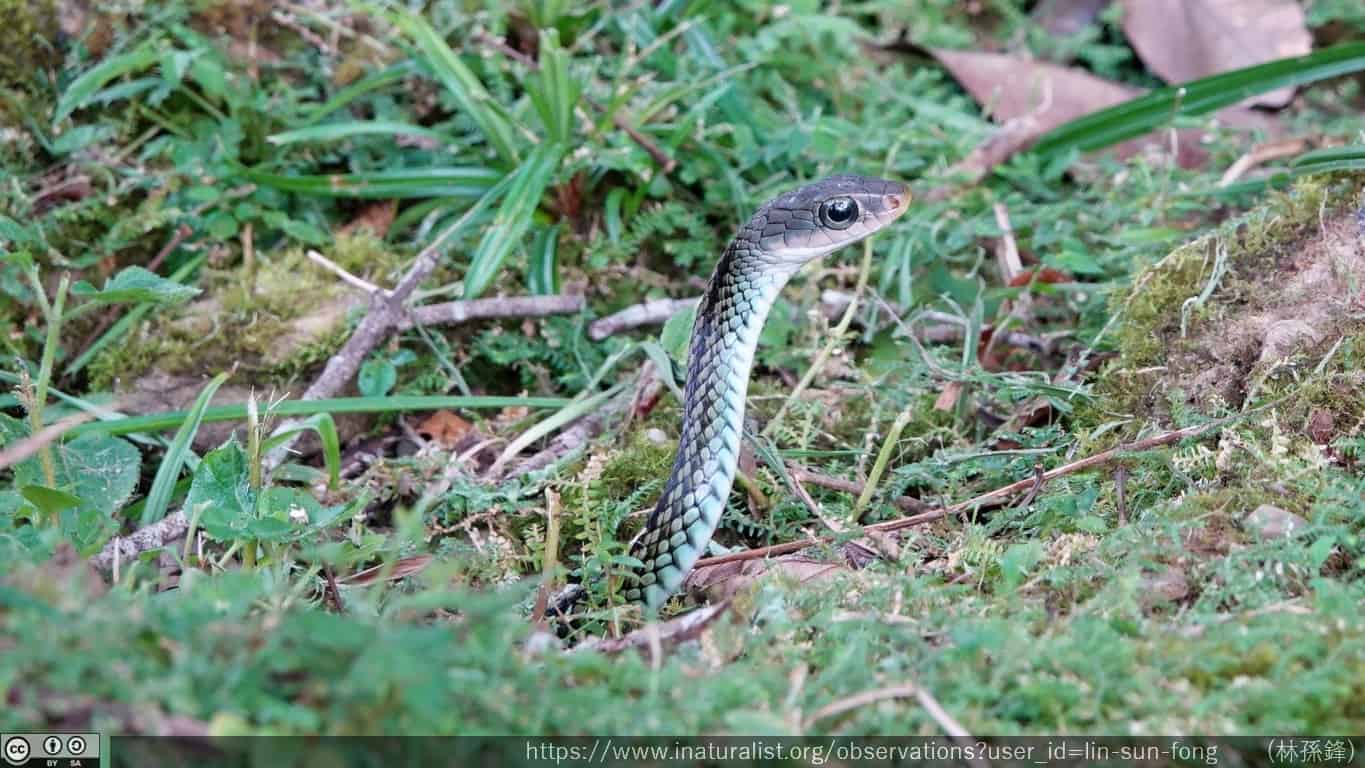
One of Taiwan’s longest snakes, at a maximum of 220cm. This species is famous not just for its large eyes, compared to their Ptyas cousins (e.g. the oriental ratsnake of Thailand), but their extreme speed. According to many sources, the big-eyed ratsnake is the fastest snake species in all of Asia. When flustered, they can vanish into thick undergrowth in a heartbeat. If cornered, they’ll slither and jerk around in an erratic manner.
Big-eyed ratsnakes (Ptyas dhumnades) inhabit most of Taiwan, usually at altitudes below 1800 metres. Further afield, they inhabit a swathe of China, even reaching Beijing to the north. It’s rare for this species to bite humans.
Big-eyed ratsnakes tend to be grey in colour, with no bright, neon scales. There’s often a bright stripe down their spine, but it’s their exceptionally fast and whippy speed which makes Ptyas dhumnades stand out. Chinese people often hunt this snake for meat, hoping it use it as medicine for leprosy, but the species is so fast that they probably fail a large portion of the time.
While mainly a ground-dwelling snake, this species often ventures up branches during hunting expeditions. Ptyas dhumnades is a confirmed egg eater, snatching eggs of the Chinese sparrowhawk and black-throated bushtit from their nests. As juveniles, they have to watch out for Futsung wolf snakes, which were confirmed as a predator in 2010. Another confirmed predator is their neighbour the Taiwan stink snake.
| 2 | Taiwan pitviper |
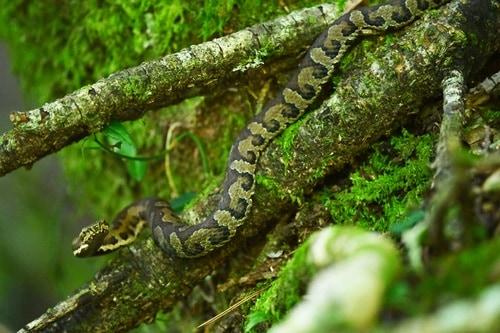
One of 5 pitvipers native to Taiwan. The Taiwan pitviper (Trimeresurus gracilis) is a particular high altitude lover, appearing only at 2000 metres or higher. Consequently, it contributes little to the island’s overall snakebite statistics. This species reaches a maximum of just 60cm, and has a bulky head, with either brown or greenish patterns.
Trimeresurus gracilis lacks neurotoxins, and instead has a venom containing 40.3% metalloproteinases. These cause both local necrosis, and spontaneous bleeding via the destruction of collagen in blood vessel linings.
No specific antivenom for the Taiwan pitviper exists. Until 2022, there were no detailed bite reports either. Two 25 year old women suffered bites, and the symptoms were nasty: the first experienced pain and swelling to her shoulder, and a haemorrhagic bullae surrounding the bite wound. When a mixed antivenom for the Taiwanese habu and Stejneger’s viper was administered, it reversed a large chunk of the effects, but not all. The woman received the antivenom late, and her finger was left permanently and irreversibly bent.
The second victim was bitten on the right index finger, and received antivenom within 1 hour. Still, the swelling passed her elbow by four hours post bite, and the forearm by nine hours, after which scientists pumped in another dose of antivenom. Because she was treated swiftly, this victim made a full recovery.
Despite their small size, Trimeresurus gracilis is a great reason to be cautious in Taiwan’s mountains.
| 3 | Black odd-scaled snake |
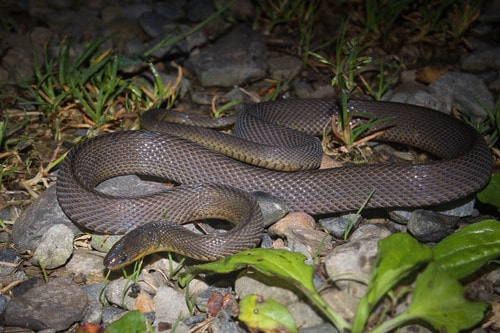
This harmless species mainly inhabits mountainous areas of Taiwan at 1000-2000 metres, rather than the western lowlands. The black-scaled odd snake (Achalinus niger) has no quarrel with humans, coexisting with local villagers peacefully.
Black-scaled odd snakes are endemic to Taiwan, occurring nowhere else. They have almost no patterns, but a great ID feature is their round, cartoon character eyes. Achalinus niger has round pupils, but because the iris is jet black as well, everything blends together into a dark black orb. Their head is instinct from the neck, carrying on like a tube.
Black-scaled odd snakes are non-venomous, and reports of bites are a mere trickle. They’re a fairly small species, with a maximum length of 80cm, and have a shimmering iridescent sheen when viewed under torchlight.
While sightings are plentiful across Taiwan, and they’re far from rare, black-scaled odd snakes are poorly researched. Its main prey is theorised to be earthworms, slugs or frogs. They’re an egg-laying species, producing roughly 7 eggs per batch, with dimensions of 1x2cm. The wider Achalinus genus has 26 members, ranging from southern China to Vietnam, and most are equally poorly researched.
| 4 | Kelung catsnake |
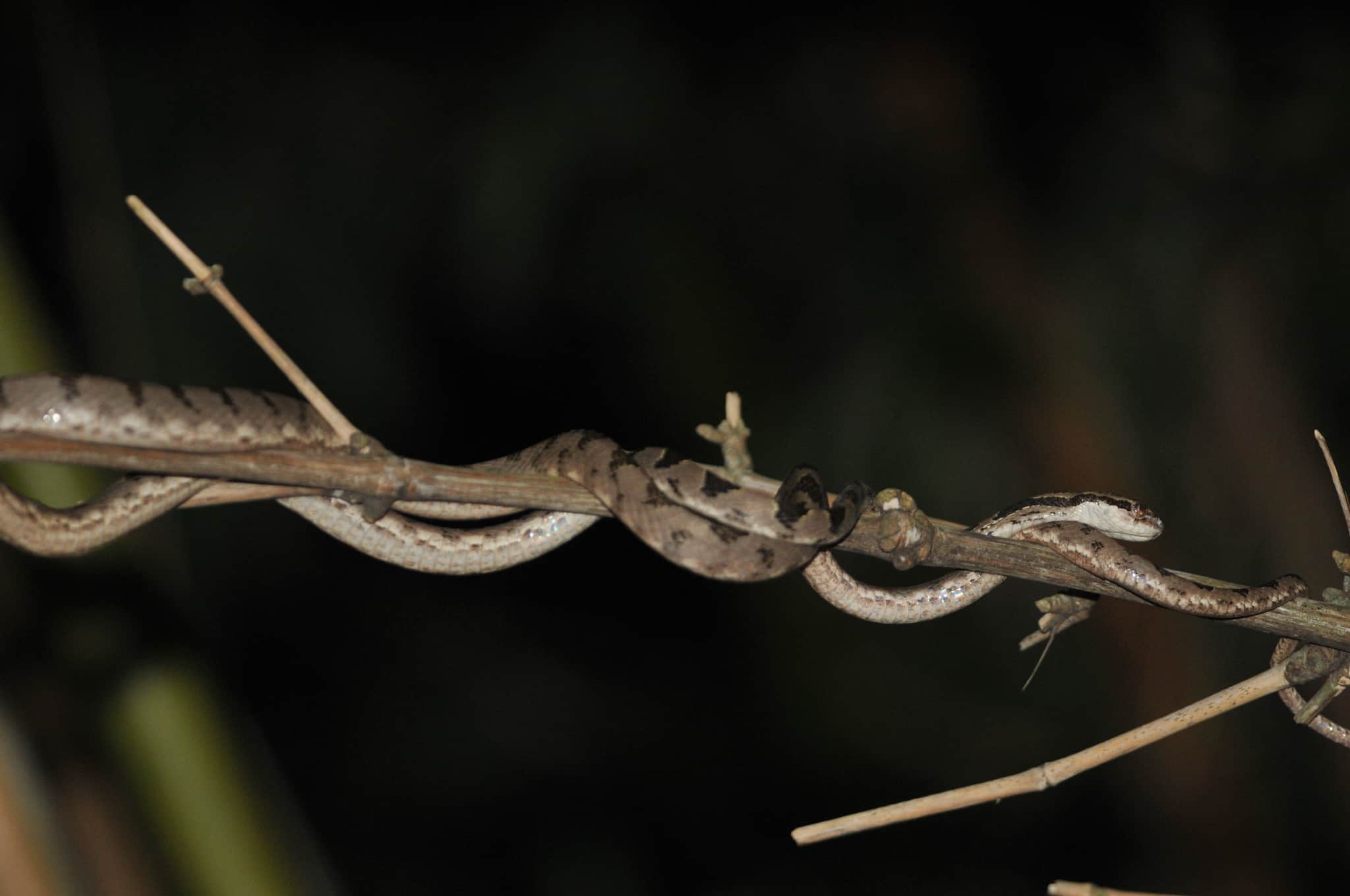
The most arboreal, or tree-dwelling snake found in Taiwan. The Boiga catsnake genus is huge, with 38 members around India and southeast Asia, but the Kelung catsnake (Boiga kraepelini) is the only species to inhabit Taiwan. They can be found in forests across the entire island, except the high central mountainous areas of over 1000 metres.
The Kelung catsnake is also one of Taiwan’s longer snakes, at a maximum of 160cm. This species has bulging eyes and sharply vertical pupils, as their catsnake name suggests. Their venom isn’t especially deadly, but this is an irritable species which won’t hesitate to lunge at anyone it dislikes from its 2 metre high branch perch.
Kelung catsnakes have a confirmed nemesis in the wild: the many-banded krait, a snake with a paralysing neurotoxic venom. This catsnake was observed with its head already in its predator’s mouth, attempting to wrap its lower body around scattered leaves, and then the krait’s own body, as the krait dragged it away. Despite this, the catsnake was sucked ever further down, and was fully swallowed 13 minutes after the scientists arrived.
Meanwhile, Kelung catsnakes are the top bird egg raider of Taiwan, including eggs of the fairy pitta, dusky fulvetta and grey-cheeked fulvetta. A 2015 study confirmed this status, finding more bird nest raidings compared to 7 other Taiwanese snakes.
| 5 | Taiwanese habu |
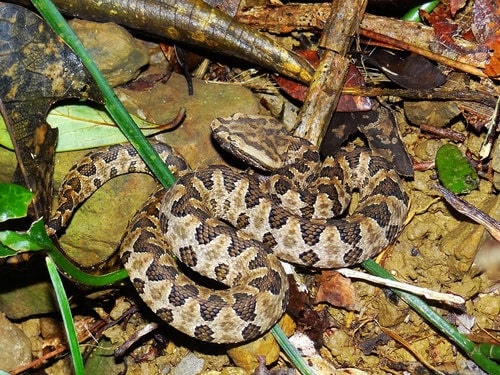
Probably the Taiwanese snake responsible for the most bites. This is a medium sized viper, with a maximum of 112cm in males, and 116cm in females.
Taiwanese habus (Protobothrops mucrosquamatus) inhabit all of Taiwan except the highly mountainous centre. This is a particularly merciless species, as the most aggressive Taiwanese habus will even lunge at moving shadows. This is a bogeyman which lurks in the dark rooms of abandoned houses and barnyards, waiting for overconfident teenagers to investigate. More typical habitats include farmlands, hillsides, forests and shrubby areas.
Taiwanese habus have featured in several large scale surveys. Firstly, a study covered 4647 Taiwanese snakebites from 2005 to 2009. Two species accounted for 71.78% of bites: the Taiwanese habu and Stejneger’s viper. The Chinese cobra and many-banded krait accounted for 19.21% collectively, while the Chinese moccasin (D. acutus) caused just 0.73%.
A 2009-2016 study dug down to the species level, involving 125 victims from northern Taiwan. 50% were caused by the Taiwanese habu, followed by 7% from Stejneger’s viper. Taiwanese habus also caused the most severe soft tissue damage, with more patients requiring surgery.
Generally, Taiwanese habus have few neurotoxic symptoms, with swelling and haemorrhaging predominating, and sudden blisters as a painful bonus symptom. Victims usually survive, but can be left with lasting deformities. Luckily, a dedicated Taiwanese habu antivenom is available.
| 6 | Blue-lipped sea krait |
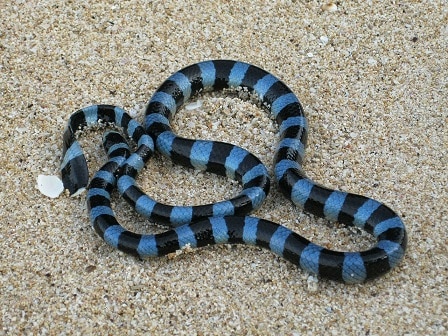
In Taiwan, it’s not just dry land where snakes are lurking around every corner, but the ocean too. There’s several sea snake species orbiting the island’s coast, and the blue-lipped sea krait (Laticauda laticauda) is plentiful, especially along the east coast. This species measures up to 150cm, outstripping a large chunk of Taiwan’s land snakes.
Blue-lipped sea kraits aren’t fully aquatic, as they regularly stray to land to rest and digest food. Their hotspots include the coastal town of Chenggong, the tropical coasts of Kenting National Park, and Orchid Island, where they coexist with their close relatives, the black-banded sea krait (Laticauda semifasciata) and banded sea krait (L. colubrina). Like other sea kraits, Laticauda laticauda has a highly neurotoxic venom, yet they’re so non-aggressive that they pose no threat to fishermen or scuba divers, except when picked up.
This species ranges from Fiji to Indonesia to Japan’s southerly Ryukyu islands. Though poorly researched, blue-lipped sea kraits produce a unique neurotoxic called laticotoxin A. Occasionally, they take shelter in the dens of birds on beaches. Likewise, blue-lipped sea kraits are proven prey of land predators such as the red-banded krait (Lycodon rufozonatus), a fellow Taiwanese snake.
| 7 | Formosa slug snake |
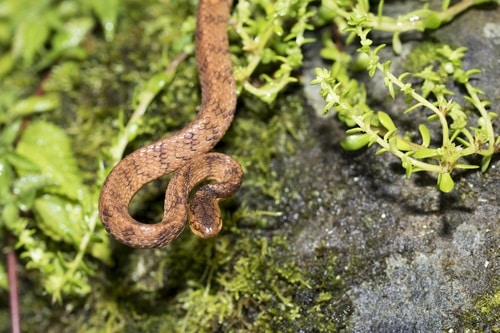
The most common slug-eating snake found in Taiwan. The Formosa slug snake (Pareas formosensis) reaches a maximum of only 70cm, and poses no threat to human beings. They’re completely non-venomous, and they lack a razor sharp pair of front fangs capable of slashing your arm. Formosa slug snakes inhabit southeast China and Vietnam, but the highest concentration of sightings is undoubtedly in Taiwan.
Pareas formosensis is a species of high altitude forest areas, where they can be found coiled up on small leaves, dripping in the rainfall. Like other Pareas slug-eaters, they have an unbalanced jaw with more teeth on their right side, allowing them to grip a snail shell and suck the soft insides free using alternating jaw retractions.
Rainfall is the secret ingredient for this snake. They hunt their slug prizes either during or immediately after rainfall, when they come out in droves. They have a surprising tolerance for cool conditions, moving around freely in low temperatures, whereas a slug snake in Thailand might hide away. The only threat from Pareas formosensis is a vile smell they release when harassed.
| 8 | Atayal slug snake |
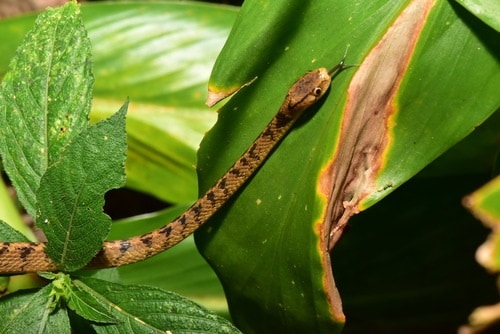
The second Pareas slug snake of our list, this harmless snake was only confirmed as an independent species in 2015. For years, scientists had noticed individuals of Formosa slug snakes with strange inconsistencies. These were originally filed as simple morphs, but detailed genetic testing revealed a new, previously overlooked species: Pareas atayal, named after a Taiwanese indigenous people.
The two species often lived side by side, but had clear differences. Paras atayal had pale yellow eyes, instead of near red for Formosa slug snakes. While the latter had completely smooth scales, the new Pareas atayal had moderately keeled (rough) scales to touch.
Additionally, P. atayal had a longer snout, and an even more unbalanced jaw, with 11 teeth on the left lower jaw and 20 on the right, versus 13 on the left and 18 on the right for Formosa slug snakes. The scientists discovered that Formosa slug snakes fed more heavily on slugs, while the new Pareas atayal gravitated more towards snails, possibly because their longer snout made extracting them easier. Genetic testing revealed a close relationship, but with easily enough separation to be full species.
Once again, Pareas atayal lives in cool, rainy forests, and is similar in length to its cousins, with an average of 50cm. This was the first discovery of an endemic Taiwan snake since 1931.
| 9 | Taiwan stink snake |
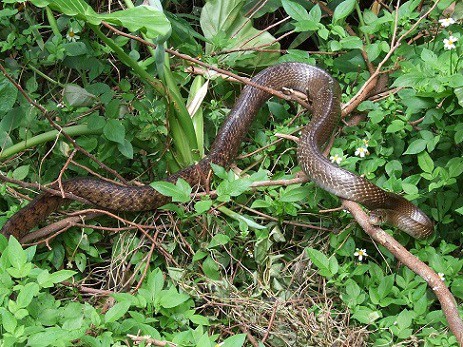
A non-venomous constrictor with a crushing grip. At up to 240cm, the Taiwan stink snake is officially the island’s longest snake. They’re thick too, one of the most heavily built of their Elaphe ratsnake genus (which has 18 members worldwide).
The Taiwan stink snake (AKA king ratsnake) inhabits all of Taiwan, plus a swathe of China. There’s a large variety in colour, from basic olive-grey to bright yellow to pale cream to almost black. Scientists originally debated whether these were subspecies, before realising that the species naturally has many morphs.
Taiwan stink snakes (Elaphe carinata) were named for the especially vile smell they produce when manhandled. One of their talents is seeking out water culverts to slither through, and they’re commonly spotted crossing roads or on garden tiles. In captivity, they’re nervous in temperament, and are always ready to strike at the slightest botherment.
Taiwan stink snakes are beloved by farmers for hoovering up rats in crop fields, but they also eat plenty of snakes: red-banded snakes, Chinese moccasins, kelung catsnakes, big-eyed ratsnakes and oriental ratsnakes.
In fact, the Taiwan stink snake can swallow pretty much anything. In 2004, two males and one female were captured by a pond in northern Taiwan’s Taoyuan county. Their stomach contents were as follows: one garden slug, one Stejneger’s grass lizard, two Formosan striped field mice, and one Tanaka’s gray shrew.
| 10 | Taiwan coral snake |
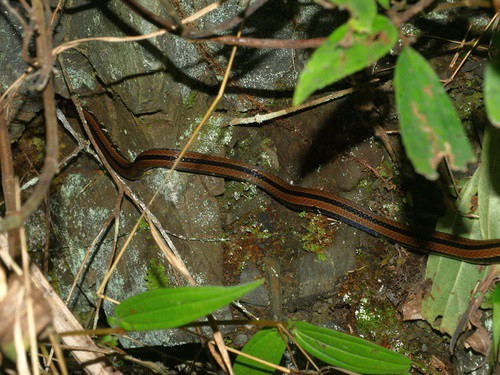
A lethal neurotoxic snake, but one that causes virtually no deaths, due to an extremely shy personality. This is a naturally rare species, which is only rarely encountered near human habitations. The Taiwan coral snake (Sinomicrurus sauteri) is endemic to Taiwan, occurring nowhere else. This is a shy species which lives primarily on forest floors in mountainous regions, lurking in dark stone cracks and decaying plant matter, moving around their domain slowly and deliberately.
Long parallel stripes of red and jet black are the main ID sign for this species. If you know what to look for, they’re easily recognisable, as no native Taiwan serpent quite resembles them. There’s also a white neck collar, and a very flat looking head. Taiwan coral snakes are mid-sized, with a maximum length of 98cm, and appear at elevations of 500-1500 metres.
The venom of this species is poorly researched. In fact, everything about them is poorly researched. But their mainland cousin, MacLelland’s coral snake, managed to kill the famous herpetologist Hans Schnurrenberger after 8 hours. Luckily, the earlier study covering 4647 Taiwanese snakebite victims mentioned zero bites from this species.

I was watching a Netflix documentary a few years ago, about the 72 most dangerous animals in Asia. I’m sure you have your reasons for not mentioning it, be it too much research involved or not enough time, or room to include this beautiful animal, but The Venom Doc, Bryan Grieg Fry, who is a venomologist, mentioned that deaths by bite are almost non-existent, because the blue Malayan coral snake is an almost impossible snake to find, and then when he found one, he laid down on the ground and demonstrated the snakes shyness by letting it give him the snakes version of a kiss on the lips, after which the snake took off in the opposite direction. According to Brian Fry, this snake sounds almost identical to the Taiwan coral snake. The blue Malaysian coral snake is super shy, and even though it’s venom is extremely lethal, as it’s a full body paralytic, and can kill a full grown adult man in 14 minutes. There are almost no reported deaths. The blue Malaysian coral snake’s venom has been being researched, at least since the program aired on August 10th 2018, to see if the snakes venom can be used to create a new pain killer, which would be 1) better and stronger than anything they have right now, and 2) will help people with real pain, but will not cause addiction like opiates do. I’m not really into snakes, and I usually get a little scared when people report how venomous they are, but I was extremely interested after listening to everything that he said, especially since I’ve had a lot of struggles with pain, and have been addicted to opiates. So in closing, I’d like to ask that maybe you could have a honorable mention section for the runners up! Anywho, even if you don’t, thank you for trying to educate people on the positive things that even deadly venomous snakes are in possession of.;D